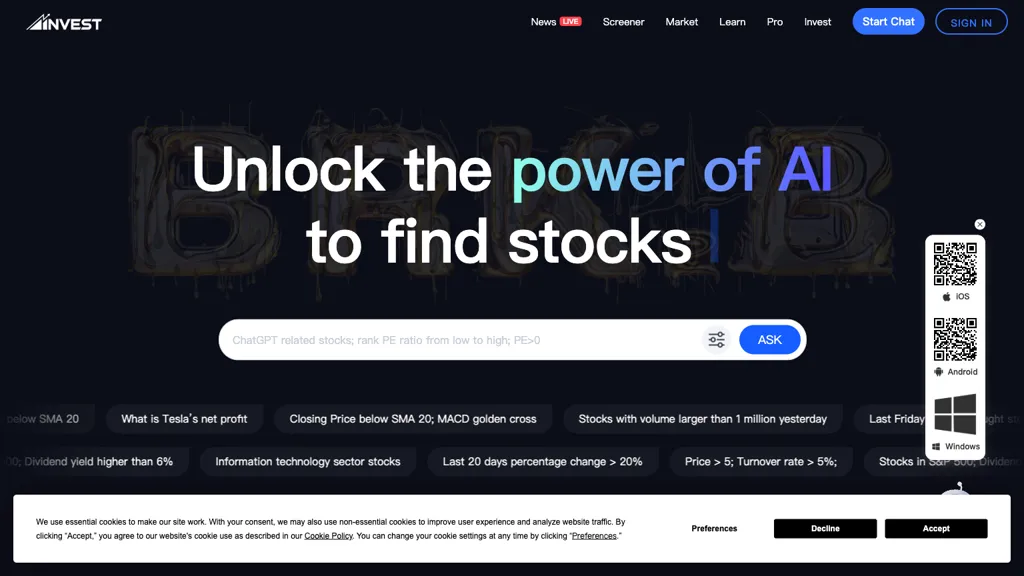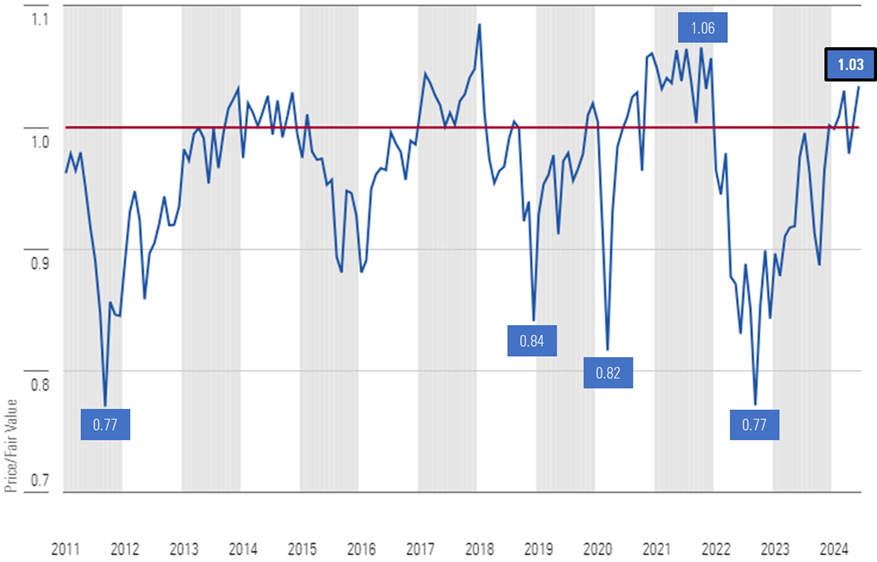To ensure that you are using a system that can provide reliable predictions and insights it is essential to assess the accuracy and efficiency of AI stock-predicting and analysis platforms. Here are the top 10 methods to assess these platforms.
1. Backtesting Results
What to Check: See if a platform has backtesting capabilities to test the effectiveness of its predictions based on previous data.
The reason it is important Backtesting can confirm the AI model's accuracy by comparing predictions to actual historical outcomes.
Find platforms that provide the ability to set up backtesting parameters.
2. Real-Time Performance Monitoring
What to look out for: Evaluate how the platform performs in market conditions that are in real-time.
Why It Matters: Real-time performance is an excellent indicator of the platform's effectiveness than backtesting using historical data alone.
Use a free trial or demo account to observe and compare real-time predictions to actual market movement.
3. Prediction Error Metrics
What to look for Analyze metrics like Mean Absolute Error (MAE) and Root Mean Squared Error (RMSE), or R-squared, to measure the accuracy of your predictions.
Why it's Important: These metrics give a quantitative measurement of how closely predictions are in line with the actual results.
Tip : Platforms with openly shared metrics tend to be more transparent.
4. Winning Rate and Ratio of Success
What to Look Out For Look for the platform's winning rate (percentage that is based on accurate predictions) and its success ratio.
What is important Why it Matters: High win rates and success ratios suggest higher accuracy in forecasting and the potential for profit.
Remember that no system is flawless.
5. Benchmarking Market Indicators
What to look out for: Check the performance and forecasts of the platform to major market indices.
What is important: It helps determine whether the platform performs better or less than the entire market.
Be sure to look for consistency in your performance, not only gains in a short period of time.
6. Consistency in Market Conditions
What to Look For: Check how the platform performs in different market conditions.
Why is it Important A solid system will perform well not only in favorable market conditions, but as well in any other circumstance.
TIP: Test the platform in volatile times or market downturns.
7. Transparency in Methodology
What to Look for: Learn about the AI algorithms and models employed (e.g. neural networks, reinforcement-learning).
What's important: Transparency allows you to examine the scientific and technological reliability of a system.
Beware of platforms that make use of models with "black boxes" without describing the process by which predictions are made.
8. User Reviews and Independent Testing
What to Look For Reviewer reviews, and search for independent testing or third-party assessments of the system.
Why It's Important The importance of independent reviews, tests and evaluations provide unbiased and objective information about the platform accuracy and performance.
Tips: To know what users think, check forums like Reddit copyright as well as financial blogs.
9. Risk-Adjusted Returns
What to look out for You should look for risk-adjusted measures, such as the Sharpe Ratio (or Sortino Ratio), to assess the platform's performance.
Why It Matters: This measure measures the risk involved in order to realize returns. It provides the most complete picture of performance.
Sharpe Ratio: If extremely high (e.g. greater than 1) This indicates higher returns when the risk factor is taken into consideration.
10. Long-term Track Record
What to look out for Check the performance of the platform over a longer period (e.g. for 3-5 year).
What's the point. Long-term performance can be more reliable than results that are short-term.
Tips: Stay away from websites that showcase only short-term success or cherry-picked results.
Bonus Tip: Make use of a Demo Account to test.
Demo accounts or free trials allow you to try out the predictions of the platform in real-time without risking actual money. It allows you to see the accuracy of predictions as well as their performance.
By following these tips by following these guidelines, you can fully examine the reliability and accuracy of AI analysis and stock prediction platforms, ensuring you choose one that aligns with your goals in trading and your risk tolerance. Don't forget that no platform can be perfect. Combining AI insights with your own research is the most effective option. Read the best my response for site tips including ai stocks, ai trading, best ai trading app, best ai for trading, investing ai, ai stock trading bot free, chart ai trading assistant, stock ai, investment ai, best ai stock trading bot free and more.

Top 10 Tips For Assessing The Latency And Speed Of Ai Trading Platforms
The speed and latency of a system is crucial when it comes to looking at AI analysis of trading platforms and stock prediction. This is particularly true for algorithmic traders, high-frequency traders and active traders. Even millisecond delays can effect on the profit of a trade. Here are the 10 best tips for measuring the speed of your platform.
1. Real-time data feeds: How do you evaluate them
Data delivery speed: Ensure the platform delivers real-time data with minimal delay (e.g. less than a millisecond delay).
Find out the distance of the source to the major exchanges.
Data compression: Check whether the platform utilizes efficient data compression techniques to speed up the delivery of data.
2. Time to test trade execution
Speed of processing orders The speed at which the platform processes and executes trades after you have submitted an order.
Direct Market Access (DMA) Check to see if the platform you are using supports DMA. This lets orders go directly to the exchange, without the need for intermediaries.
Execution Reports: Check if your platform provides detailed reports on the execution of orders, with timestamps.
3. Review the responsiveness of the Platform
User interface (UI), speed test the platform's response time to inputs.
Chart updates: Verify whether charts and visualizations are updated in real-time without lag.
Performance of mobile applications: When using a mobile app, make sure it is at the same speed as a desktop version.
4. Check for Low Latency Infrastructure
Server Locations: Select servers that are low-latency, and located close to major financial centers or exchanges.
Find co-location alternatives. These services permit you to host your algorithm near the exchange.
High-speed networks: Check whether the platform is using fiber-optic networks with high speeds or other low-latency technology.
5. Evaluating Simulation and Backtesting speed
Historical data processing: See how quickly your platform analyzes and processes data from the past.
Simulation latency: Ensure the platform can simulate trades in real-time with no noticeable delay.
Parallel processing: Make sure the platform is using parallel processing, also known as distributed computing, which speeds up complex computations.
6. Calculate the API Latency
API response time: Determine how quickly the platform's API responds to requests (e.g., fetching market information, or placing orders).
Rate limits: Make sure that the API is within reasonable limits for rates in order to avoid delays when high-frequency trading is taking place.
WebSockets support: Verify that your platform is using WebSockets protocol for low-latency, real-time streaming of data.
7. Test Platform Stability and Stability under load
High-volume trades: To test the platform’s ability to respond and stability, you can simulate high-volume scenarios.
Market volatility: Test the platform during times of high volatility to see if it can handle rapid pricing shifts.
Stress testing: Find out if the platform offers the tools to stress test your strategies in extreme circumstances.
8. Assess Network and Connectivity
Internet speed requirements. Check that your internet connection has the minimum speeds recommended for your platform to ensure optimal performance.
Connections that are redundant: Make sure you know that your platform is equipped with redundant internet connections. This will allow you to prevent the possibility of downtime.
VPN latency: If you use a VPN be sure to check if it introduces significant latency. Also, determine if the provider provides alternatives.
9. Look for features that speed up your speed.
Pre-trade analyses: The platform should provide analysis of the trade in order to improve order routing and execution speeds.
Smart Order Routing (SOR). Check if the platform utilizes SOR in order to locate the fastest and most efficient execution sites.
Monitoring of latency: Make sure your platform permits you to monitor and analyze your latency on a live basis.
10. Review Feedback from Users and Benchmarks
User feedback: Use user reviews to determine the performance of the platform in terms of speed and latency.
Benchmarks by third-parties: Check for reviews and benchmarks from independent sources that compare the platform's performance to those of its competitors.
Case studies: Check whether a platform offers instances or case studies which highlight the features that are low-latency.
Bonus Tips
Free trial period: Test the platform's speed and latency in real-world scenarios by using the demo or free trial.
Customer support: Ensure the platform has assistance for issues related to latency or optimization.
Hardware specifications. Check if the platform works with a specific type of hardware, such as high-performance computers.
With these suggestions that you will be able to assess the performance and speed of AI platform for predicting or analyzing stocks, ensuring you choose one that is compatible with your trading needs and minimizes the time it takes to complete. The need for low latency is vital for high-frequency and algorithmic traders. Even minor delays can have a significant impact on profitability. Take a look at the best free ai stock picker url for site recommendations including ai stock prediction, ai options, best stock prediction website, ai trading tool, ai copyright signals, ai stock trader, stocks ai, how to use ai for copyright trading, stock trading ai, ai copyright signals and more.
